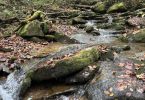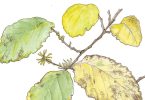
(Left) Before image of stream crossing near campground. (Right) After image of stream crossing, rock armored to prevent sedimentation
By Emma Castleberry
A legacy trail that had fallen into severe disrepair has been fully restored and reestablished as an official US Forest Service system trail, connecting two major trail complexes in Pisgah National Forest. Now officially named the Old Lanning Ridge Trail, the route runs between the Cove Creek Group Campground and Lanning Ridge Road. The project—coordinated by The Pisgah Conservancy and executed by Elevated Trail Design—reopens a key trail connector while reducing environmental degradation and enhancing the user experience.
For decades, the old trail—originally a Forest Service system route—was left unmaintained after being used for timber access in the 1980s. Despite no longer being on the official trail system, it continued to be used by hikers and bikers, leading to significant deterioration. “It served an important purpose, it needed rehabilitation as a trail and it needed rehabilitation as a potential harm to local aquatic ecosystems,” says Jeff Maitz, trail specialist with The Pisgah Conservancy. The trail had no drainage features, extensive entrenchment and a major landslide that created a deep hole over a tributary of Cove Creek.
Because the trail was “shovel-ready,” having already undergone environmental reviews as part of the larger Butter Gap Project, The Pisgah Conservancy prioritized its restoration. Legacy trails like this one are common in Pisgah. Many were originally rail or road beds used for timber extraction and later adapted for recreational use. “With a wide trail,” says Maitz, “it becomes much more difficult for trail crews to maintain the trail for drainage with only hand tools—light equipment becomes necessary to adequately maintain effective drainage on many of these trails.”
Because of limited maintenance capacity, these trails can suffer from soil loss and erosion, and become harmful to ecosystems. “Old Lanning Ridge is an example of something a little different but similar—it was actually taken off the system, retired as a trail, in the 1980s, but there was no decommissioning or rehabilitation work to actually remove it and rehabilitate the landscape.”

(Left) Before image of rutted-out trail. (Right) Jeff Maitz in after image of rutted-out trail. Photos courtesy of The Pisgah Conservancy
Peter Mills, owner and founder of Elevated Trail Design, led the team that performed the restoration work in April. “The creek crossing next to the campground is a highlight improvement that I am very proud of,” says Mills. “This area was an entrenched muddy mess that was actively allowing sediment and dirt to enter the creek. Now the approach from either end and the entire creek crossing are armored with stone and the water is now flowing clear.” Mills says his team worked hard to stabilize the area while staying true to its “original character and classic Pisgah feel and style.”
Rehabilitation work included rock armoring at four locations, removal of an old culvert, improved drainage with 35 reverse grade dips, revegetation, regrading, and the construction of a 20’ by 10’ stone crib wall. One 160-foot section of the trail was rerouted to move it out of a ditch and onto a sidehill, providing more sustainable drainage. “This trail was a historical alignment that is now officially re-named and on the map,” says Mills.
The newly restored trail also improves safety and connectivity for forest users. “It will connect campground users at Cove Creek Group Campground with durable, sustainable access to the waterfalls and swimming holes of the Daniel Ridge area and other trail users with more connective access to Cove Creek Falls and Cove Creek and Caney Bottom trails,” says Maitz.
Importantly, it also gives hikers and bikers an alternative to using Davidson River Road. “There is no longer a large hole in the middle of the trail, and by bringing the trail back on the USFS system, it will be able to be maintained and cared for into the future to prevent future degradation,” says Maitz.
Mills says it was rewarding to work close to home. “It is important to myself and my team because we enjoy Pisgah National Forest and it is always a treat to work close to home in the forest we love.”
Learn more at PisgahConservancy.org.






